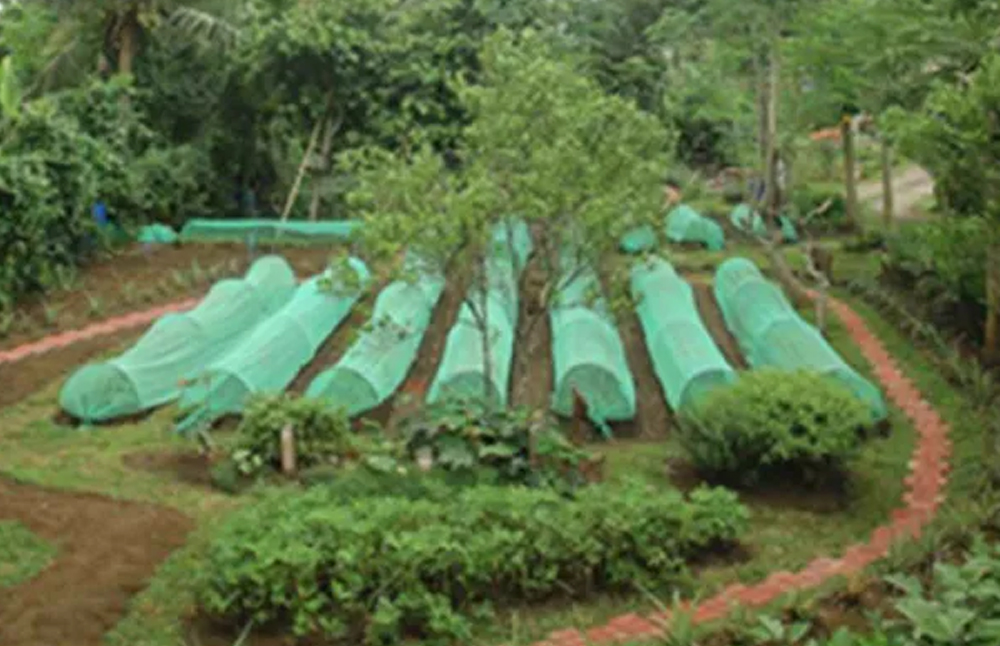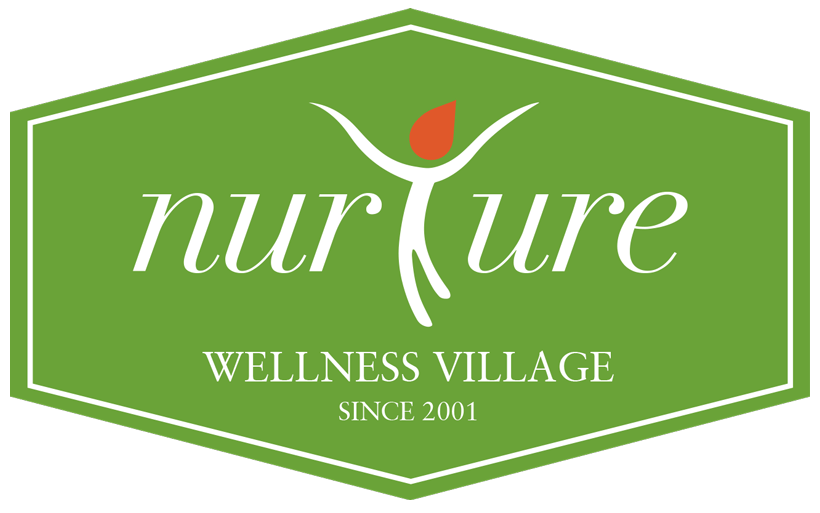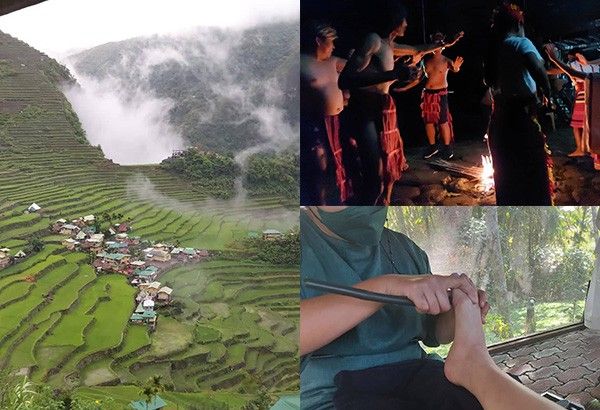
Business World Feature
Farm Tourism: For Health and Travel
IF A SECRET is made to be kept, then the Department of Tourism (DoT) is not to be trusted with it, because it is endorsing a secret garden in Tagaytay, Cavite. Only three hours away from Metro Manila is a not-so-hidden garden called the Nurture Wellness Village, a getaway that promotes green and clean living where visitors can walk barefoot, eat fresh and organic produce, and literally stop and smell the flowers.
The 1.5-hectare resort, which marked its 15th year in operation on Oct. 14, invited the DoT and the press to tour its Nurture Farmacy, which is part of the village and is a DoT accredited farm tourism destination that aims for a total body wellness. At the Farmacy garden is a sprawling green area called Phythotherapy: Plants that Heal, where each plant bed is shaped like a body organ. For example, the “brain garden,” which is shaped like a brain, has all the plants that are good for the brain growing in it, including thyme, ginseng, peanut, rosemary, kale, oregano, eggplant, and lettuce. The “heart garden” includes the fruits and vegetables for a healthier heart: garlic, tomato, zucchini, pepper, lettuce, and cayenne; while the “stomach garden” includes mint, celery, parsley, aloe vera, pandan (screwpine), wheat grass, and lemongrass, which known to promote good digestion. The plants are nice to look at and nicer to smell and touch, but they cannot be picked. If you plan to buy a plant, there is the adjacent store for that.
“Health is always about prevention, but if you do get sick, you do have alternative medicines like massage, plants, and exercise — but in emergencies you go to the conventional hospital,” said Nurture Wellness Village owner Catherine Turvill.
“Usually, we are not here to cure but to prevent sickness, because not everything is about popping pills. Research based lahat ito (all of this),” she added. What started as a simple spa garden 15 years ago has grown into a wedding and team building venue, and, now, a promotional site for traditional culture and organic farming. Ms. Turvill said the village “has matured through the years, certainly. The core of the business is wellness. We are all about sustainability. Yes, we do have massage, but what we have is a whole wellness experience.”
Asked if majority of its visitors are the old and the ailing, she said: “Magugulat ka marami kaming family and bata na interesado to be healthy (You’ll be surprised to know that we have a lot of families and young people who are interested in being healthy). They want to have fun and integrate wellness.”
The 1.5-hectare resort, which marked its 15th year in operation on Oct. 14, invited the DoT and the press to tour its Nurture Farmacy, which is part of the village and is a DoT accredited farm tourism destination that aims for a total body wellness. At the Farmacy garden is a sprawling green area called Phythotherapy: Plants that Heal, where each plant bed is shaped like a body organ. For example, the “brain garden,” which is shaped like a brain, has all the plants that are good for the brain growing in it, including thyme, ginseng, peanut, rosemary, kale, oregano, eggplant, and lettuce. The “heart garden” includes the fruits and vegetables for a healthier heart: garlic, tomato, zucchini, pepper, lettuce, and cayenne; while the “stomach garden” includes mint, celery, parsley, aloe vera, pandan (screwpine), wheat grass, and lemongrass, which known to promote good digestion. The plants are nice to look at and nicer to smell and touch, but they cannot be picked. If you plan to buy a plant, there is the adjacent store for that.
“Health is always about prevention, but if you do get sick, you do have alternative medicines like massage, plants, and exercise — but in emergencies you go to the conventional hospital,” said Nurture Wellness Village owner Catherine Turvill.
“Usually, we are not here to cure but to prevent sickness, because not everything is about popping pills. Research based lahat ito (all of this),” she added. What started as a simple spa garden 15 years ago has grown into a wedding and team building venue, and, now, a promotional site for traditional culture and organic farming. Ms. Turvill said the village “has matured through the years, certainly. The core of the business is wellness. We are all about sustainability. Yes, we do have massage, but what we have is a whole wellness experience.”
Asked if majority of its visitors are the old and the ailing, she said: “Magugulat ka marami kaming family and bata na interesado to be healthy (You’ll be surprised to know that we have a lot of families and young people who are interested in being healthy). They want to have fun and integrate wellness.”
FARM TOURISM IN THE PHILIPPINES
The DoT is now tapping the concept of farm tourism, which includes the Nurture Wellness Village, among others. “Farm
tourism is relatively new but once developed, especially with the mandate of the Farm Tourism Development Act of 2016, inclusive growth becomes achievable for the benefit of farmers, micro to small business entrepreneurs, and other community stakeholders,” said DoT Assistant Secretary Frederick Alegre at the sidelines of the Nurture Farmacy event.
The Farm Tourism Development Act defines “farm tourism” as “the practice of attracting visitors and tourists to farm areas for production, educational, and recreational purposes. It involves any agricultural — or fishery — based operation or activity that brings to a farm visitors, tourists, farmers, and fisherfolks who want to be educated and trained on farming and its related activities and provides a venue for outdoor recreation and accessible family outings.”
Some examples of farm tourism sites in the Philippines include the mango farms in Guimaras, Duran farm in Bulacan for a tour of the best vegetable production, and the strawberry and organic farms in Benguet. “I believe we have to spur the growth [in tourism] outside Manila. I believe the majority of the tourists don’t want traffic, they want to move from places like this (farms as tourist spots). If we don’t start pushing visits to places like this, we can never really achieve the market, the numbers, we want,” said Mr. Alegre.
He said the DoT is looking at 12 million tourist arrivals per year by 2022. Meanwhile, he said the department is confident it will reach the six million tourist arrival target by the end of this year. He also mentioned the other plans of DoT to achieve its visitor target including “having a new Web site with better presence online,” and looking for one iconic place in the Philippines to represent the country — but he said: “but it is hard, because there are many.”
The Farm Tourism Development Act defines “farm tourism” as “the practice of attracting visitors and tourists to farm areas for production, educational, and recreational purposes. It involves any agricultural — or fishery — based operation or activity that brings to a farm visitors, tourists, farmers, and fisherfolks who want to be educated and trained on farming and its related activities and provides a venue for outdoor recreation and accessible family outings.”
Some examples of farm tourism sites in the Philippines include the mango farms in Guimaras, Duran farm in Bulacan for a tour of the best vegetable production, and the strawberry and organic farms in Benguet. “I believe we have to spur the growth [in tourism] outside Manila. I believe the majority of the tourists don’t want traffic, they want to move from places like this (farms as tourist spots). If we don’t start pushing visits to places like this, we can never really achieve the market, the numbers, we want,” said Mr. Alegre.
He said the DoT is looking at 12 million tourist arrivals per year by 2022. Meanwhile, he said the department is confident it will reach the six million tourist arrival target by the end of this year. He also mentioned the other plans of DoT to achieve its visitor target including “having a new Web site with better presence online,” and looking for one iconic place in the Philippines to represent the country — but he said: “but it is hard, because there are many.”

